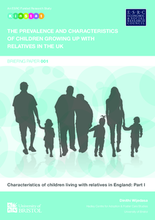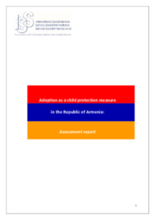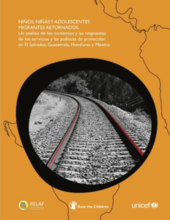Demographic Data
|
Sources: World Bank, UNICEF, UNDP HDR 2015, DHS 2011 |
Displaying 11711 - 11720 of 14389
This literature review highlights the voices of looked after children in the UK from existing research, on their journey through the care system.
This thesis paper employed qualitative methods to capture the online interaction of undergraduate volunteers as part of an undergraduate-student mentorship program. This program was developed to provide mentorship and tutoring for at-risk-youth at a foster care institution.
This briefing paper is the first in a series, from an Economic and Social Research Council (ESRC) funded research study. The study explores the prevalence and characteristics of children growing up in kinship care in the UK using 2011 Census microdata.
This report includes a number of observations about the adoption situation in Armenia as well as makes diverse recommendations targeting key actors.
This case study of the child protection system in the United Republic of Tanzania is part of a UNICEF global initiative, undertaken in collaboration with Global Affairs Canada to document national child protection frameworks to gain an understanding of the country, the response of government and other actors, as well as other factors contributing to success in protecting children from violence, exploitation and abuse.
This study intended to develop data regarding how families parent and nurture good behaviour in their children; whether they know what would constitute nonviolent (positive) discipline; and if they actually utilized the positive aspects of disciplining. The study was conducted in specific areas (study clusters) in Kenya, Uganda, Ethiopia and Rwanda.
This study tested the capacity to perceive visual expressions of emotion, and to use those expressions as guides to social decisions, in three groups of 8- to 10-year-old Romanian children: children abandoned to institutions then randomly assigned to remain in ‘care as usual’ (institutional care); children abandoned to institutions then randomly assigned to a foster care intervention; and community children who had never been institutionalized.
El objetivo del estudio es presentar el proceso de construcción de una herramienta para medir la institucionalización en forma rápida, a partir de información existente en los países y mostrar los principales datos que se obtuvieron.
Esta evaluación rápida busca cubrir la escasez de información sobre las políticas y los servicios de las entidades gubernamentales y no gubernamentales encargadas de la protección de los derechos de niños, niñas y adolescentes migrantes retornados a sus sociedades de origen en los países del Triángulo del Norte y México, con un foco en las acciones tendientes a restituir el derecho a la convivencia familiar y la integración comunitaria.
This briefing outlines what current research tells us about the nature of peer-on-peer abuse, and considers what this might mean for building a response.








